Microeconomics Assignment: Demand and Supply of Australian Cheese
VerifiedAdded on 2022/12/15
|8
|1417
|160
Homework Assignment
AI Summary
This assignment analyzes the Australian cheese market through a microeconomic lens. It addresses three key questions: factors affecting cheese demand in Australia, the price elasticity of demand for Australian cheese, and the impact of a price floor on the cheese market. The solution utilizes demand and supply models, illustrating the effects of imports, international buyers, and drought on equilibrium price and quantity. The analysis also explores whether the demand for Australian cheese is price elastic or inelastic, and examines how a price floor affects consumer and producer surplus, and market efficiency. The solution includes graphical representations and references to support its arguments.
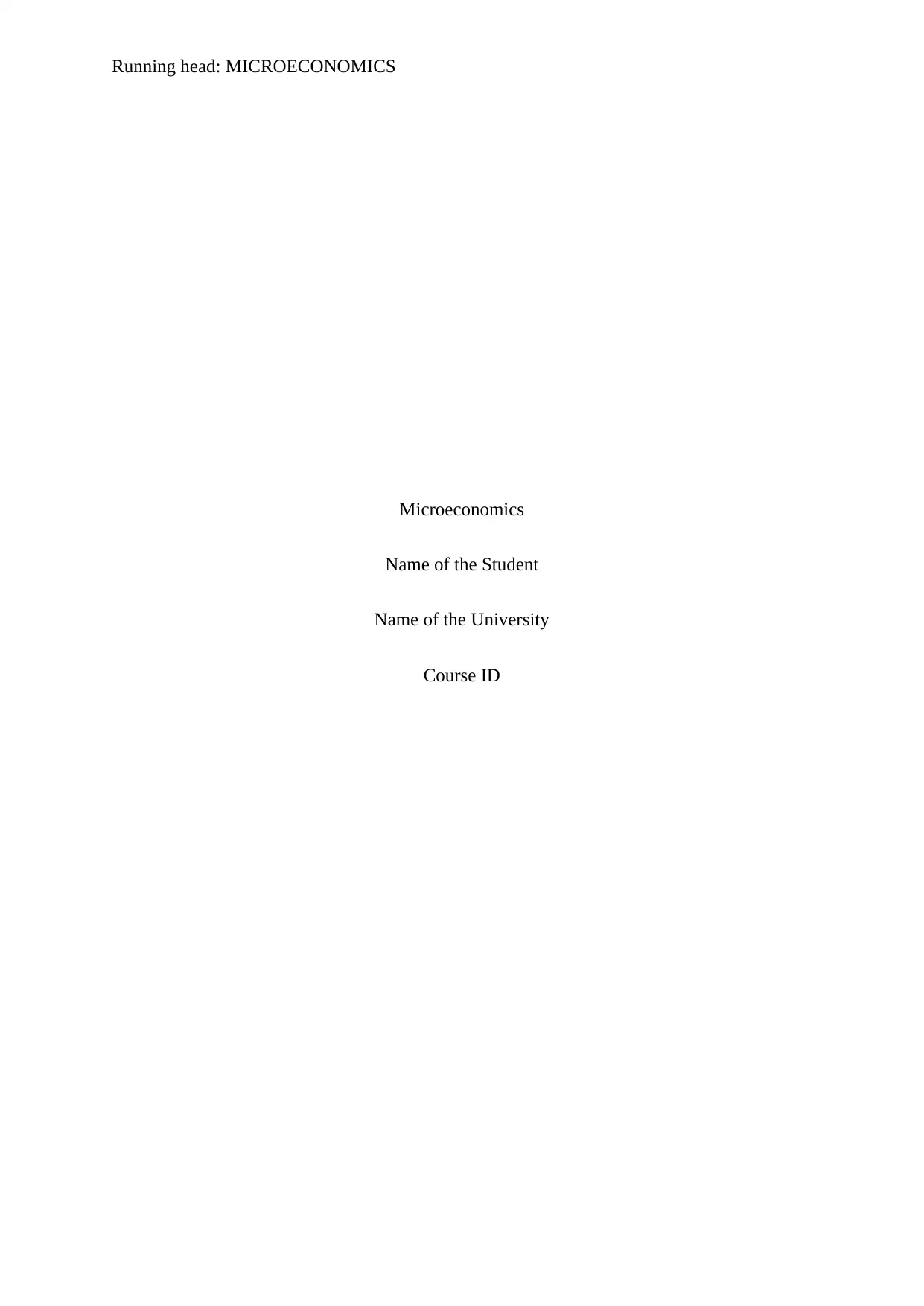
Running head: MICROECONOMICS
Microeconomics
Name of the Student
Name of the University
Course ID
Microeconomics
Name of the Student
Name of the University
Course ID
Paraphrase This Document
Need a fresh take? Get an instant paraphrase of this document with our AI Paraphraser
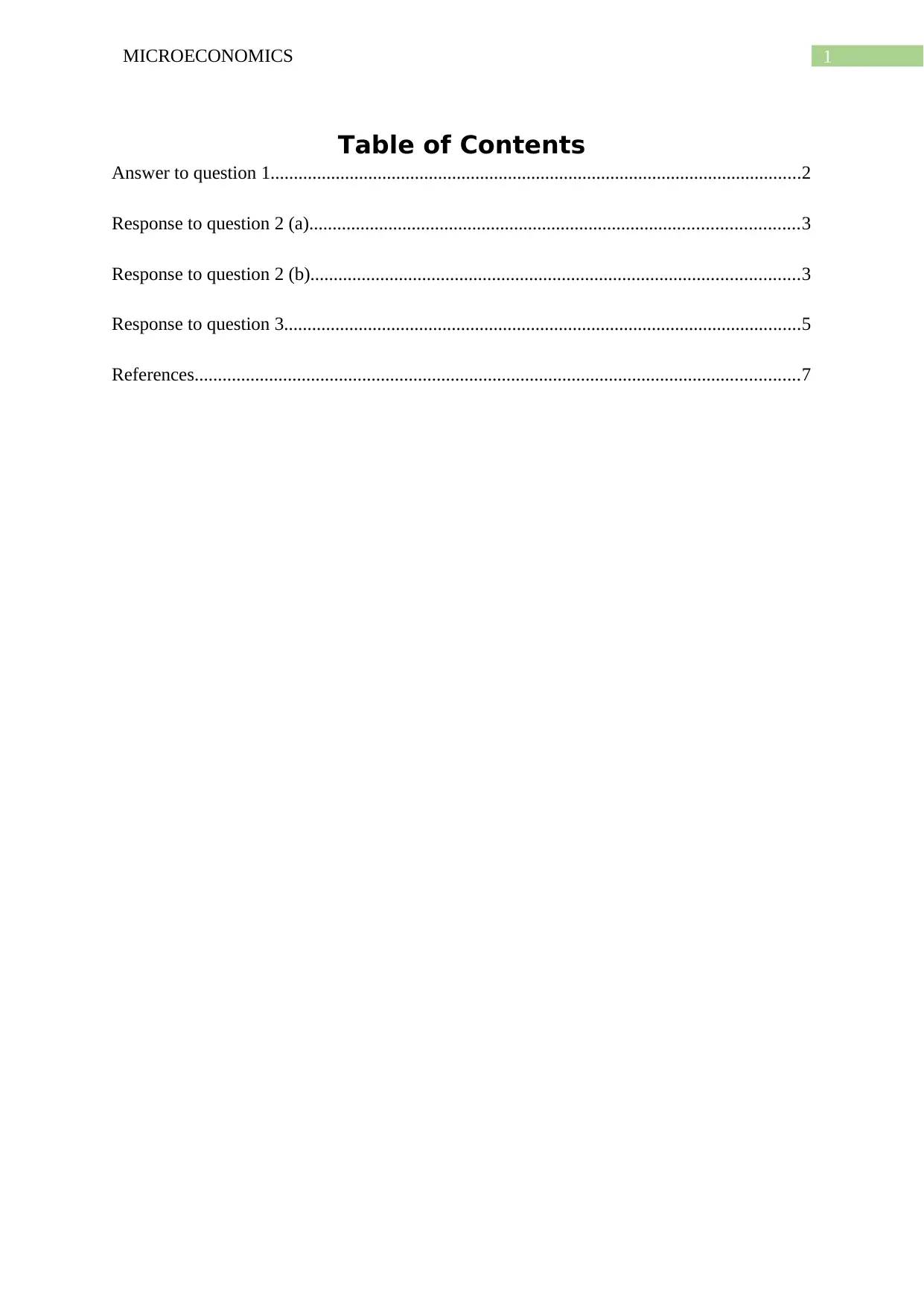
1MICROECONOMICS
Table of Contents
Answer to question 1..................................................................................................................2
Response to question 2 (a).........................................................................................................3
Response to question 2 (b).........................................................................................................3
Response to question 3...............................................................................................................5
References..................................................................................................................................7
Table of Contents
Answer to question 1..................................................................................................................2
Response to question 2 (a).........................................................................................................3
Response to question 2 (b).........................................................................................................3
Response to question 3...............................................................................................................5
References..................................................................................................................................7
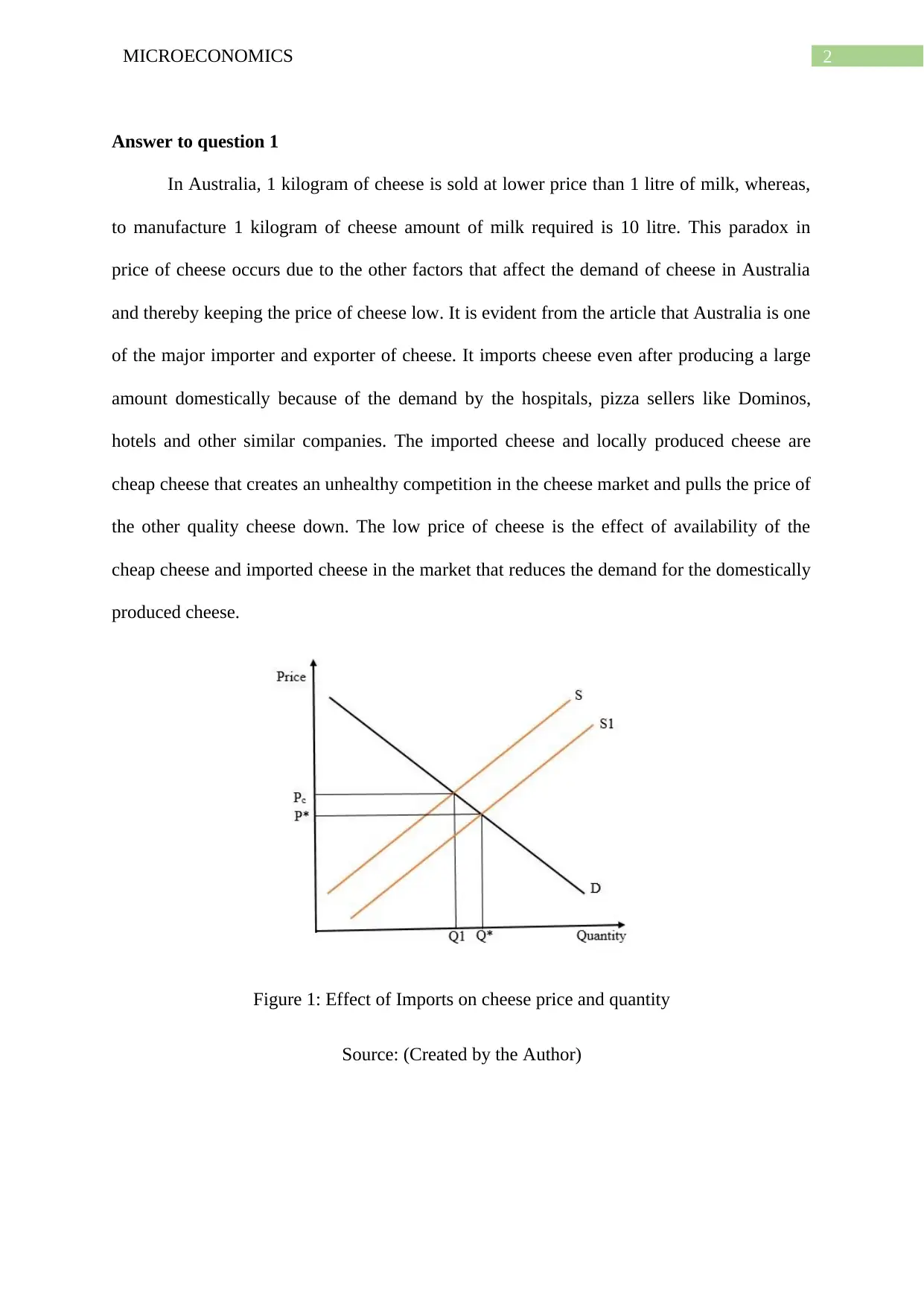
2MICROECONOMICS
Answer to question 1
In Australia, 1 kilogram of cheese is sold at lower price than 1 litre of milk, whereas,
to manufacture 1 kilogram of cheese amount of milk required is 10 litre. This paradox in
price of cheese occurs due to the other factors that affect the demand of cheese in Australia
and thereby keeping the price of cheese low. It is evident from the article that Australia is one
of the major importer and exporter of cheese. It imports cheese even after producing a large
amount domestically because of the demand by the hospitals, pizza sellers like Dominos,
hotels and other similar companies. The imported cheese and locally produced cheese are
cheap cheese that creates an unhealthy competition in the cheese market and pulls the price of
the other quality cheese down. The low price of cheese is the effect of availability of the
cheap cheese and imported cheese in the market that reduces the demand for the domestically
produced cheese.
Figure 1: Effect of Imports on cheese price and quantity
Source: (Created by the Author)
Answer to question 1
In Australia, 1 kilogram of cheese is sold at lower price than 1 litre of milk, whereas,
to manufacture 1 kilogram of cheese amount of milk required is 10 litre. This paradox in
price of cheese occurs due to the other factors that affect the demand of cheese in Australia
and thereby keeping the price of cheese low. It is evident from the article that Australia is one
of the major importer and exporter of cheese. It imports cheese even after producing a large
amount domestically because of the demand by the hospitals, pizza sellers like Dominos,
hotels and other similar companies. The imported cheese and locally produced cheese are
cheap cheese that creates an unhealthy competition in the cheese market and pulls the price of
the other quality cheese down. The low price of cheese is the effect of availability of the
cheap cheese and imported cheese in the market that reduces the demand for the domestically
produced cheese.
Figure 1: Effect of Imports on cheese price and quantity
Source: (Created by the Author)
⊘ This is a preview!⊘
Do you want full access?
Subscribe today to unlock all pages.

Trusted by 1+ million students worldwide
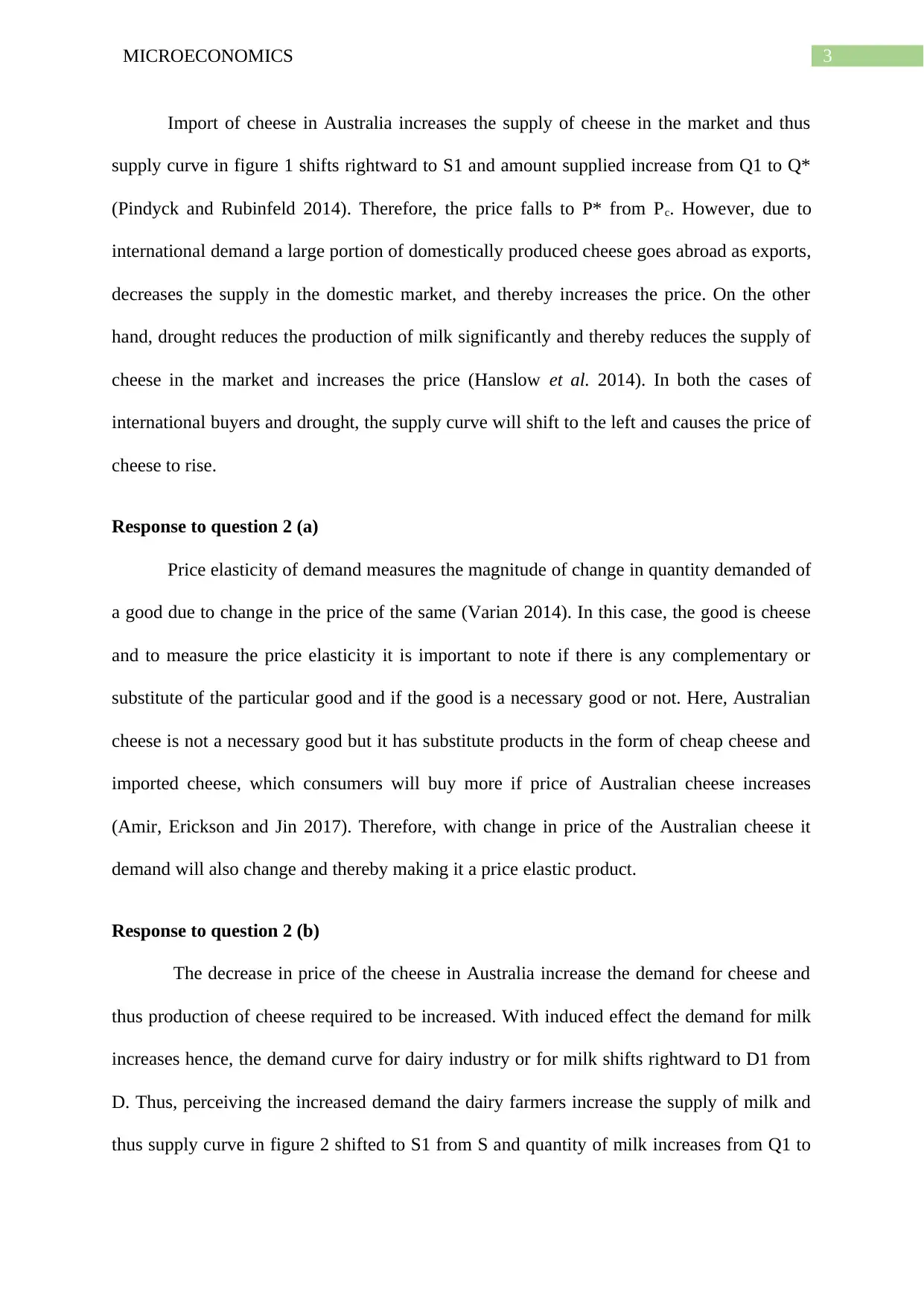
3MICROECONOMICS
Import of cheese in Australia increases the supply of cheese in the market and thus
supply curve in figure 1 shifts rightward to S1 and amount supplied increase from Q1 to Q*
(Pindyck and Rubinfeld 2014). Therefore, the price falls to P* from Pc. However, due to
international demand a large portion of domestically produced cheese goes abroad as exports,
decreases the supply in the domestic market, and thereby increases the price. On the other
hand, drought reduces the production of milk significantly and thereby reduces the supply of
cheese in the market and increases the price (Hanslow et al. 2014). In both the cases of
international buyers and drought, the supply curve will shift to the left and causes the price of
cheese to rise.
Response to question 2 (a)
Price elasticity of demand measures the magnitude of change in quantity demanded of
a good due to change in the price of the same (Varian 2014). In this case, the good is cheese
and to measure the price elasticity it is important to note if there is any complementary or
substitute of the particular good and if the good is a necessary good or not. Here, Australian
cheese is not a necessary good but it has substitute products in the form of cheap cheese and
imported cheese, which consumers will buy more if price of Australian cheese increases
(Amir, Erickson and Jin 2017). Therefore, with change in price of the Australian cheese it
demand will also change and thereby making it a price elastic product.
Response to question 2 (b)
The decrease in price of the cheese in Australia increase the demand for cheese and
thus production of cheese required to be increased. With induced effect the demand for milk
increases hence, the demand curve for dairy industry or for milk shifts rightward to D1 from
D. Thus, perceiving the increased demand the dairy farmers increase the supply of milk and
thus supply curve in figure 2 shifted to S1 from S and quantity of milk increases from Q1 to
Import of cheese in Australia increases the supply of cheese in the market and thus
supply curve in figure 1 shifts rightward to S1 and amount supplied increase from Q1 to Q*
(Pindyck and Rubinfeld 2014). Therefore, the price falls to P* from Pc. However, due to
international demand a large portion of domestically produced cheese goes abroad as exports,
decreases the supply in the domestic market, and thereby increases the price. On the other
hand, drought reduces the production of milk significantly and thereby reduces the supply of
cheese in the market and increases the price (Hanslow et al. 2014). In both the cases of
international buyers and drought, the supply curve will shift to the left and causes the price of
cheese to rise.
Response to question 2 (a)
Price elasticity of demand measures the magnitude of change in quantity demanded of
a good due to change in the price of the same (Varian 2014). In this case, the good is cheese
and to measure the price elasticity it is important to note if there is any complementary or
substitute of the particular good and if the good is a necessary good or not. Here, Australian
cheese is not a necessary good but it has substitute products in the form of cheap cheese and
imported cheese, which consumers will buy more if price of Australian cheese increases
(Amir, Erickson and Jin 2017). Therefore, with change in price of the Australian cheese it
demand will also change and thereby making it a price elastic product.
Response to question 2 (b)
The decrease in price of the cheese in Australia increase the demand for cheese and
thus production of cheese required to be increased. With induced effect the demand for milk
increases hence, the demand curve for dairy industry or for milk shifts rightward to D1 from
D. Thus, perceiving the increased demand the dairy farmers increase the supply of milk and
thus supply curve in figure 2 shifted to S1 from S and quantity of milk increases from Q1 to
Paraphrase This Document
Need a fresh take? Get an instant paraphrase of this document with our AI Paraphraser
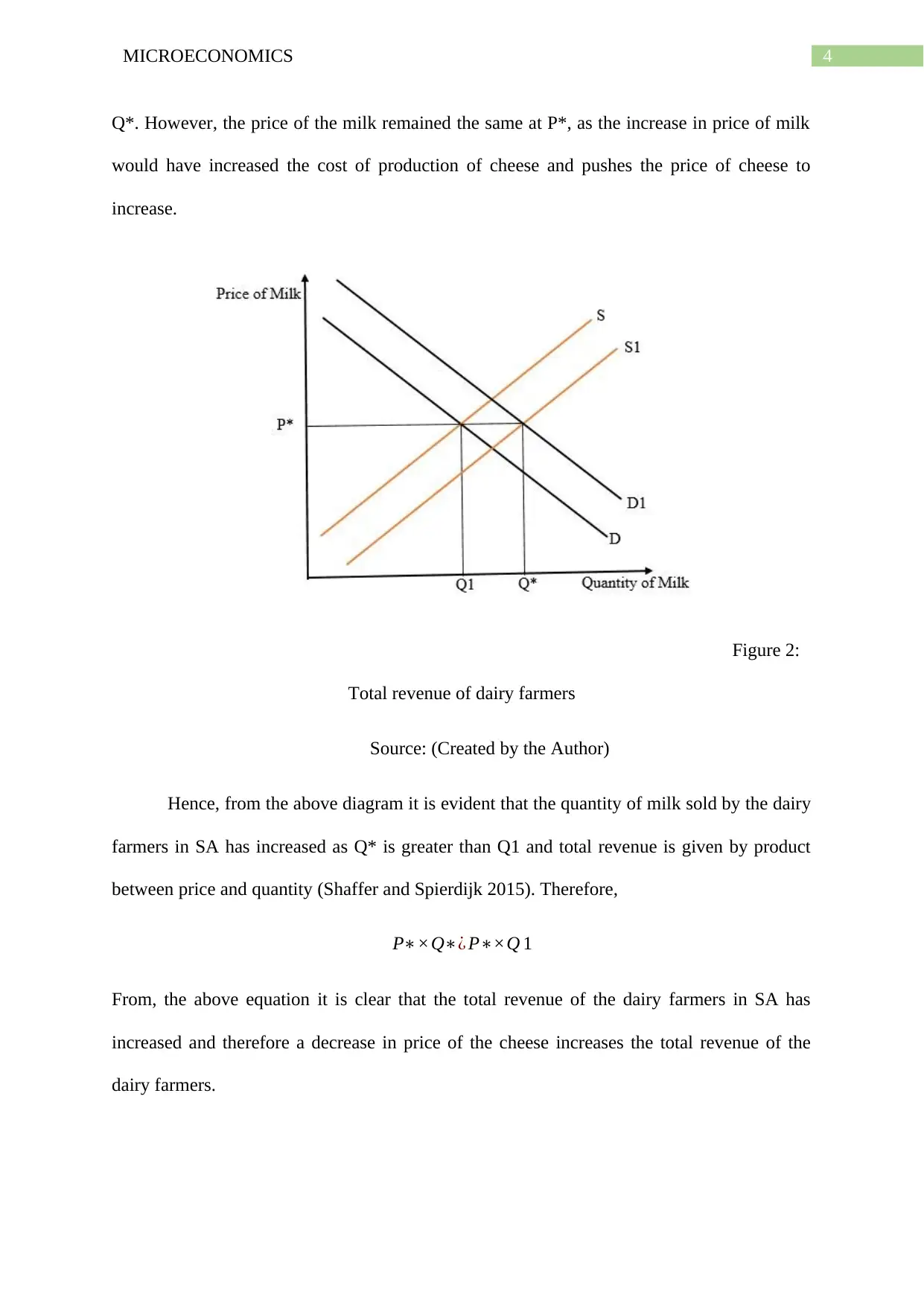
4MICROECONOMICS
Q*. However, the price of the milk remained the same at P*, as the increase in price of milk
would have increased the cost of production of cheese and pushes the price of cheese to
increase.
Figure 2:
Total revenue of dairy farmers
Source: (Created by the Author)
Hence, from the above diagram it is evident that the quantity of milk sold by the dairy
farmers in SA has increased as Q* is greater than Q1 and total revenue is given by product
between price and quantity (Shaffer and Spierdijk 2015). Therefore,
P∗×Q∗¿ P∗×Q 1
From, the above equation it is clear that the total revenue of the dairy farmers in SA has
increased and therefore a decrease in price of the cheese increases the total revenue of the
dairy farmers.
Q*. However, the price of the milk remained the same at P*, as the increase in price of milk
would have increased the cost of production of cheese and pushes the price of cheese to
increase.
Figure 2:
Total revenue of dairy farmers
Source: (Created by the Author)
Hence, from the above diagram it is evident that the quantity of milk sold by the dairy
farmers in SA has increased as Q* is greater than Q1 and total revenue is given by product
between price and quantity (Shaffer and Spierdijk 2015). Therefore,
P∗×Q∗¿ P∗×Q 1
From, the above equation it is clear that the total revenue of the dairy farmers in SA has
increased and therefore a decrease in price of the cheese increases the total revenue of the
dairy farmers.
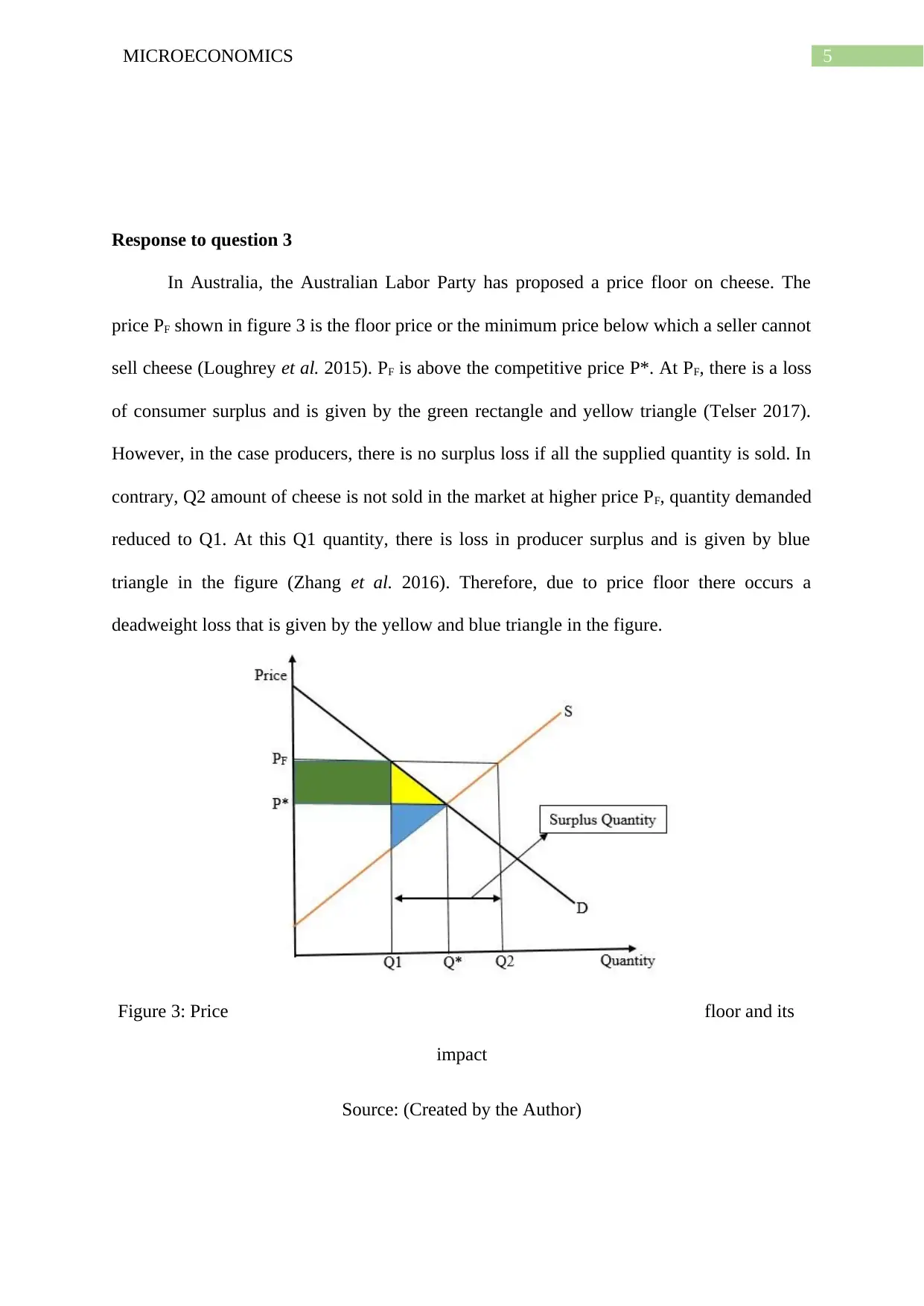
5MICROECONOMICS
Response to question 3
In Australia, the Australian Labor Party has proposed a price floor on cheese. The
price PF shown in figure 3 is the floor price or the minimum price below which a seller cannot
sell cheese (Loughrey et al. 2015). PF is above the competitive price P*. At PF, there is a loss
of consumer surplus and is given by the green rectangle and yellow triangle (Telser 2017).
However, in the case producers, there is no surplus loss if all the supplied quantity is sold. In
contrary, Q2 amount of cheese is not sold in the market at higher price PF, quantity demanded
reduced to Q1. At this Q1 quantity, there is loss in producer surplus and is given by blue
triangle in the figure (Zhang et al. 2016). Therefore, due to price floor there occurs a
deadweight loss that is given by the yellow and blue triangle in the figure.
Figure 3: Price floor and its
impact
Source: (Created by the Author)
Response to question 3
In Australia, the Australian Labor Party has proposed a price floor on cheese. The
price PF shown in figure 3 is the floor price or the minimum price below which a seller cannot
sell cheese (Loughrey et al. 2015). PF is above the competitive price P*. At PF, there is a loss
of consumer surplus and is given by the green rectangle and yellow triangle (Telser 2017).
However, in the case producers, there is no surplus loss if all the supplied quantity is sold. In
contrary, Q2 amount of cheese is not sold in the market at higher price PF, quantity demanded
reduced to Q1. At this Q1 quantity, there is loss in producer surplus and is given by blue
triangle in the figure (Zhang et al. 2016). Therefore, due to price floor there occurs a
deadweight loss that is given by the yellow and blue triangle in the figure.
Figure 3: Price floor and its
impact
Source: (Created by the Author)
⊘ This is a preview!⊘
Do you want full access?
Subscribe today to unlock all pages.

Trusted by 1+ million students worldwide
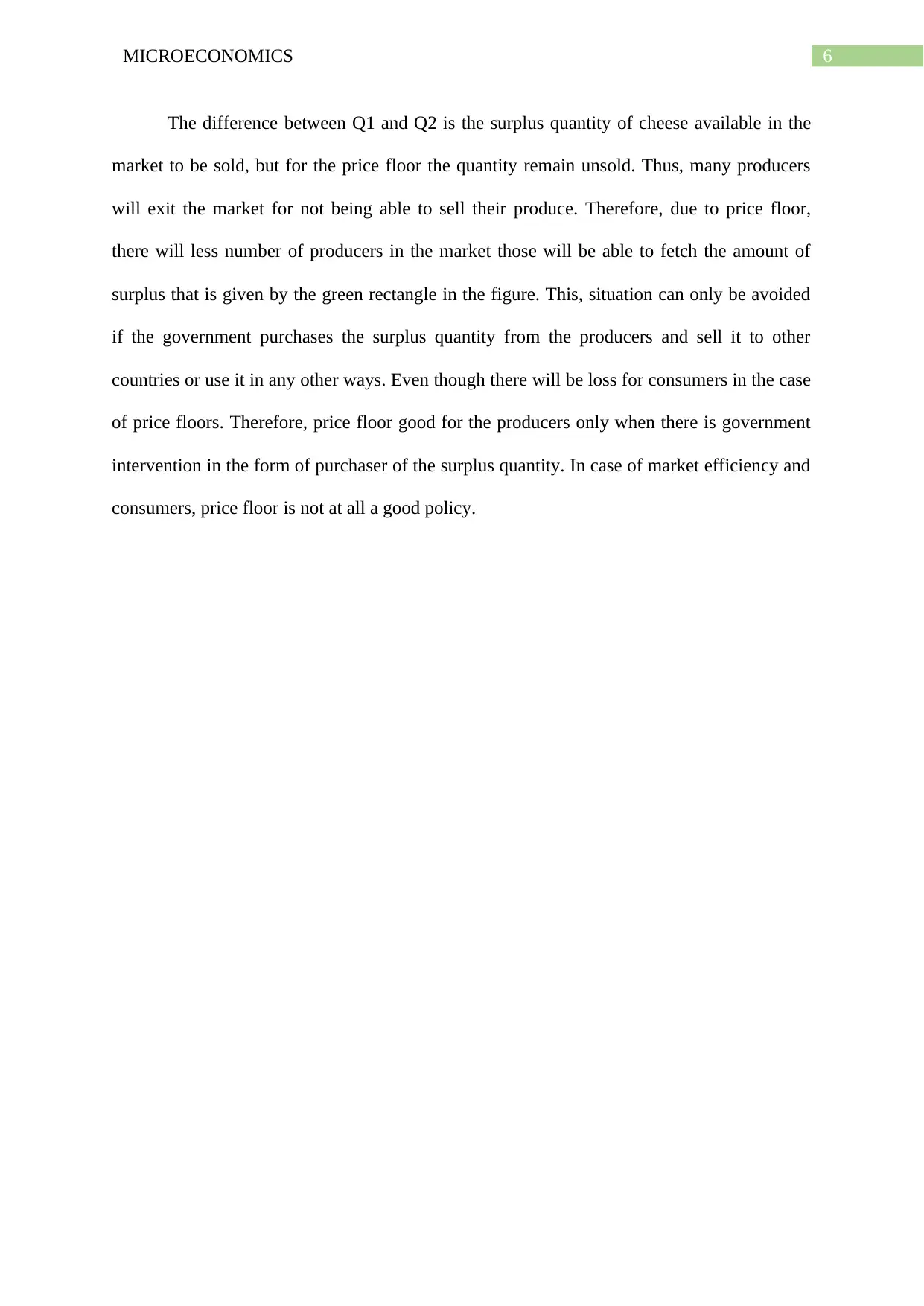
6MICROECONOMICS
The difference between Q1 and Q2 is the surplus quantity of cheese available in the
market to be sold, but for the price floor the quantity remain unsold. Thus, many producers
will exit the market for not being able to sell their produce. Therefore, due to price floor,
there will less number of producers in the market those will be able to fetch the amount of
surplus that is given by the green rectangle in the figure. This, situation can only be avoided
if the government purchases the surplus quantity from the producers and sell it to other
countries or use it in any other ways. Even though there will be loss for consumers in the case
of price floors. Therefore, price floor good for the producers only when there is government
intervention in the form of purchaser of the surplus quantity. In case of market efficiency and
consumers, price floor is not at all a good policy.
The difference between Q1 and Q2 is the surplus quantity of cheese available in the
market to be sold, but for the price floor the quantity remain unsold. Thus, many producers
will exit the market for not being able to sell their produce. Therefore, due to price floor,
there will less number of producers in the market those will be able to fetch the amount of
surplus that is given by the green rectangle in the figure. This, situation can only be avoided
if the government purchases the surplus quantity from the producers and sell it to other
countries or use it in any other ways. Even though there will be loss for consumers in the case
of price floors. Therefore, price floor good for the producers only when there is government
intervention in the form of purchaser of the surplus quantity. In case of market efficiency and
consumers, price floor is not at all a good policy.
Paraphrase This Document
Need a fresh take? Get an instant paraphrase of this document with our AI Paraphraser
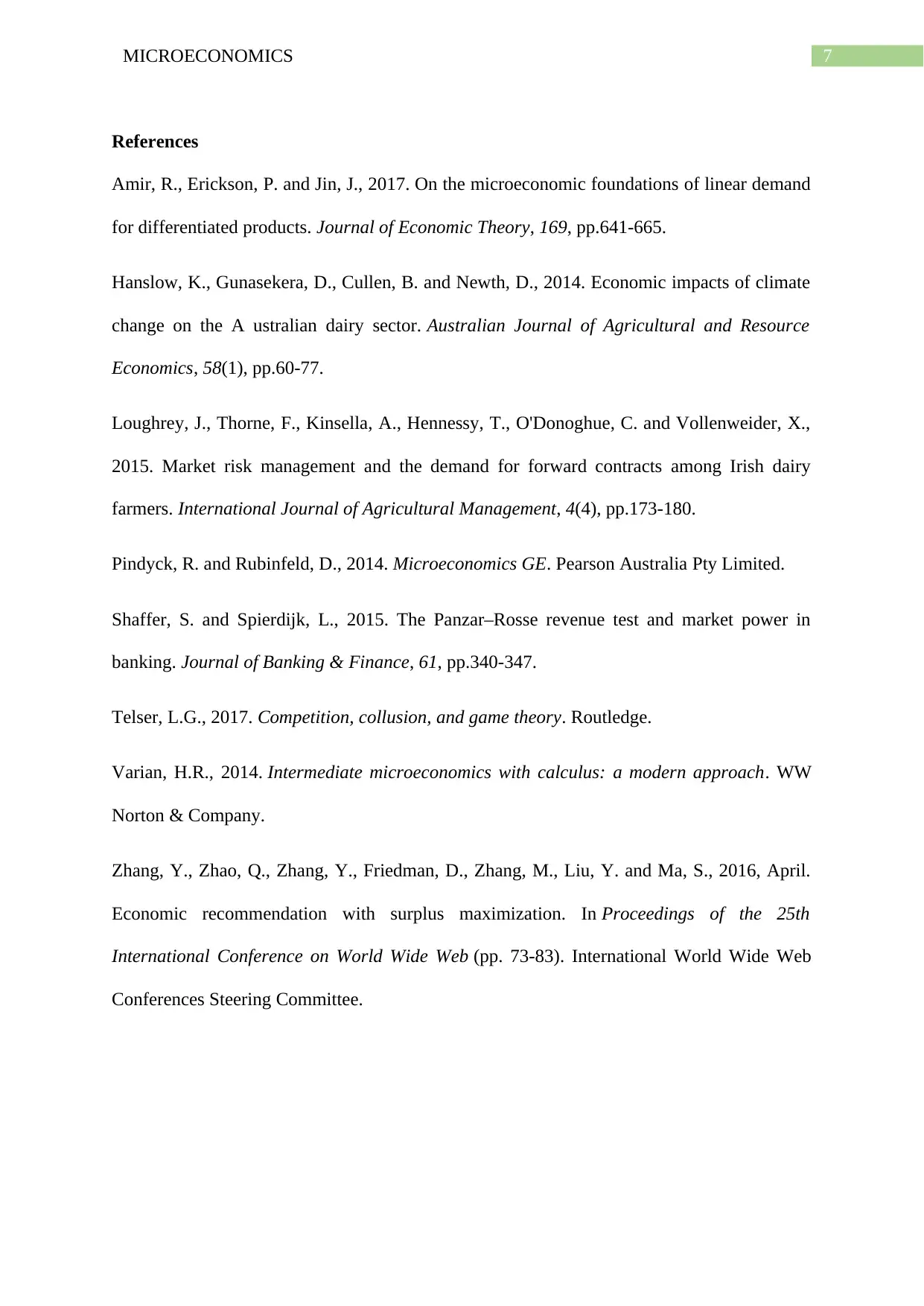
7MICROECONOMICS
References
Amir, R., Erickson, P. and Jin, J., 2017. On the microeconomic foundations of linear demand
for differentiated products. Journal of Economic Theory, 169, pp.641-665.
Hanslow, K., Gunasekera, D., Cullen, B. and Newth, D., 2014. Economic impacts of climate
change on the A ustralian dairy sector. Australian Journal of Agricultural and Resource
Economics, 58(1), pp.60-77.
Loughrey, J., Thorne, F., Kinsella, A., Hennessy, T., O'Donoghue, C. and Vollenweider, X.,
2015. Market risk management and the demand for forward contracts among Irish dairy
farmers. International Journal of Agricultural Management, 4(4), pp.173-180.
Pindyck, R. and Rubinfeld, D., 2014. Microeconomics GE. Pearson Australia Pty Limited.
Shaffer, S. and Spierdijk, L., 2015. The Panzar–Rosse revenue test and market power in
banking. Journal of Banking & Finance, 61, pp.340-347.
Telser, L.G., 2017. Competition, collusion, and game theory. Routledge.
Varian, H.R., 2014. Intermediate microeconomics with calculus: a modern approach. WW
Norton & Company.
Zhang, Y., Zhao, Q., Zhang, Y., Friedman, D., Zhang, M., Liu, Y. and Ma, S., 2016, April.
Economic recommendation with surplus maximization. In Proceedings of the 25th
International Conference on World Wide Web (pp. 73-83). International World Wide Web
Conferences Steering Committee.
References
Amir, R., Erickson, P. and Jin, J., 2017. On the microeconomic foundations of linear demand
for differentiated products. Journal of Economic Theory, 169, pp.641-665.
Hanslow, K., Gunasekera, D., Cullen, B. and Newth, D., 2014. Economic impacts of climate
change on the A ustralian dairy sector. Australian Journal of Agricultural and Resource
Economics, 58(1), pp.60-77.
Loughrey, J., Thorne, F., Kinsella, A., Hennessy, T., O'Donoghue, C. and Vollenweider, X.,
2015. Market risk management and the demand for forward contracts among Irish dairy
farmers. International Journal of Agricultural Management, 4(4), pp.173-180.
Pindyck, R. and Rubinfeld, D., 2014. Microeconomics GE. Pearson Australia Pty Limited.
Shaffer, S. and Spierdijk, L., 2015. The Panzar–Rosse revenue test and market power in
banking. Journal of Banking & Finance, 61, pp.340-347.
Telser, L.G., 2017. Competition, collusion, and game theory. Routledge.
Varian, H.R., 2014. Intermediate microeconomics with calculus: a modern approach. WW
Norton & Company.
Zhang, Y., Zhao, Q., Zhang, Y., Friedman, D., Zhang, M., Liu, Y. and Ma, S., 2016, April.
Economic recommendation with surplus maximization. In Proceedings of the 25th
International Conference on World Wide Web (pp. 73-83). International World Wide Web
Conferences Steering Committee.
1 out of 8
Related Documents
Your All-in-One AI-Powered Toolkit for Academic Success.
+13062052269
info@desklib.com
Available 24*7 on WhatsApp / Email
![[object Object]](/_next/static/media/star-bottom.7253800d.svg)
Unlock your academic potential
Copyright © 2020–2025 A2Z Services. All Rights Reserved. Developed and managed by ZUCOL.





